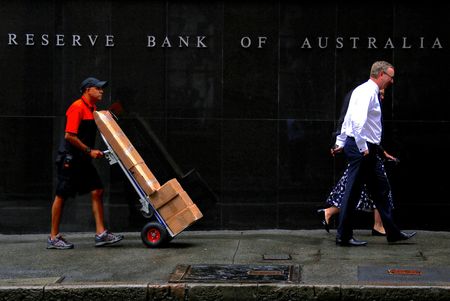By Wayne Cole
SYDNEY (Reuters) -Australian employment posted a disappointingly small rise in September in a hint that a very tight labour market might finally be loosening, lessening pressure for faster increases in interest rates.
Figures from the Australian Bureau of Statistics on Thursday showed net employment rose just 900 in September, short of market forecasts of 25,000 and well down on August’s jump of 36,300. Hours worked were also flat, suggesting some cooling in activity.
The miss on jobs supports the Reserve Bank of Australia’s (RBA) decision this month to slow the pace of rate hikes to quarter-point moves, having already lifted rates by 250 basis points since May.
“The sharp slowdown in employment growth vindicates the RBA’s decision, but we doubt it will prevent the Bank from hiking its cash rate further,” said Marcel Thieliant, a senior economist at Capital Economics.
“After all, our composite measure of job vacancies suggests that the unemployment rate will remain around the current very low levels for a while yet.”
The jobless rate held near 48-year lows at 3.5% in September, while the participation was just off record highs at 66.6%.
Full-time employment firmed 13,300, while total job gains for the 12 months to September were still up a huge 691,200 testifying to the strength of the market for much of this year.
VACANCIES APLENTY
The demand for labour remains resilient with firms listing a lack of suitable workers as their number one problem, while job advertisements have eased only slightly from record highs.
Official data show one vacancy for every person unemployed, compared to a ratio of one to three before the pandemic.
This is a major reason why markets fully expect another rate rise of 25 basis points in November. Rates are tipped to reach as high as 4.25% by the middle of next year, in part because the U.S. Federal Reserve looks set to tighten policy drastically.
The RBA has argued it can afford to go slower than the Fed since wages in Australia are growing at half the pace of those in the United States, even with a very tight labour market.
While there have been signs of some firms paying up to attract and keep workers, many sectors are covered by multi-year wage agreements that are slow to respond to cost pressures.
The central bank’s patience could be tested next week when figures for third-quarter consumer prices are released and are likely to show annual inflation running at a 32-year high around 7.0%.
An even higher outcome would increase pressure for a shift back to half-point rate hikes in coming months, particularly as floods in eastern Australia are expected to lift food prices.
“An upside surprise would be problematic for the RBA,” said Catherine Birch, a senior economist at ANZ.
“Longer-term, the risks look tilted to the upside given continuing cost pass-through, the current flooding, lower AUD and evidence of persistence in inflationary pressures globally.”
(Reporting by Wayne Cole; Editing by Jacqueline Wong and Ana Nicolaci da Costa)

